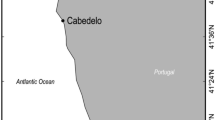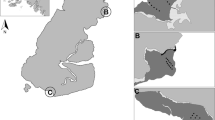Abstract
During two field studies the macrofauna associated with wrack stranded on a tropical sandy shore was analysed. During the first period all animals present in small wrack deposits were randomly collected with cores. During the second field study active animals were sampled in larger wrack deposits for an entire lunar period, and tube traps were used. After a comparison between the two studies, only the data from the tube traps were examined from a temporal and spatial point of view. The aim of the present work was to gain information on how, when and where wrack was colonised by invertebrates, kee** in mind cyclical aspects such as lunar, diel and tidal phases. Predatory taxa, such as Staphylinoidea and the amphipods Talorchestia martensii, were most abundant, whereas Diptera larvae and Tenebrionidae were scarce. Successional changes of beach wrack colonisation were evident throughout a semi-lunar period, with molluscs invading wrack during the first days of deposition and histerids during the last ones. Strictly nocturnal or diurnal surface-active species were found to be active in the wrack during both the day and the night. The analysis of the tidal component of species activity in the wrack showed that some species moved at ebbing tide, and others moved at rising tide. Differences were found also in the mean hours of tidal activity, calculated separately during day and night periods. The study of the zonation of each species showed that in some cases wrack deposits were closely followed by the fauna as their position changed during the semi-lunar phase. In other cases differences occurred between species zonation during day and night periods and tidal phases. Cluster analysis indicates that most species exploit the wrack in different ways (as refuges and/or feeding site), both in space and in time.
Similar content being viewed by others
Author information
Authors and Affiliations
Additional information
Received: 11 July 1999 / Accepted: 20 January 2000
Rights and permissions
About this article
Cite this article
Colombini, I., Aloia, A., Fallaci, M. et al. Temporal and spatial use of stranded wrack by the macrofauna of a tropical sandy beach. Marine Biology 136, 531–541 (2000). https://doi.org/10.1007/s002270050713
Issue Date:
DOI: https://doi.org/10.1007/s002270050713




